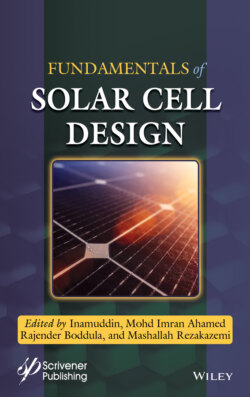Читать книгу Fundamentals of Solar Cell Design - Rajender Boddula - Страница 32
2.2 Principles and Working Mechanism of Plasmonic Solar Cells 2.2.1 Working Principle
ОглавлениеA plasmonic nanostructure can be used as direct and indirect applications such as active PV material and plasmon modified active semiconductor, respectively [29]. The fundamental operational principle of plasmonic solar cell is scattering through SPR in metallic nanoparticles on semiconductor and surface plasmon polaritons at the metal/semiconductor interface.
Solar cell performance mostly depends on photon energy and active PV layers. When a photon falls on the surface of semiconductor, the photons will pass through material (if photons have energy lower than the semiconductor band gap, Ephotons < Eg) and photons will reflect from the surface or they will be absorbed by the semiconductor layer (if photons have energy higher than the band gap of semiconductor, Ephotons > Eg). The unused sunlight produces heat in the solar cell through lattice vibrations and decreases the performance. An electron is excited into conduction band from the valance band due to the illumination of light and creates hole in semiconductor. Thus, absorbed photon generates e-h pair in the semiconductor. The electrons and holes have tendency to recombine due to their opposite charge, so they can be separated and the electrons can be collected as a flow of current. The fast collection of electrons would produce more electricity. Plasmonic nanostructures decrease the loss of incident photons by increasing optical path length in PV devices [30]. The very thin semiconducting layer absorbs less sunlight and hence the plasmonic nanostructures are used to enhance the absorption through scattering at resonance wavelengths in solar cell. The thinner conducting material will make quick collection of electrons but thin surface absorbs less photons. Hence, the thickness of photoactive material needs to be tuned for achieving maximum absorption of light, which will help to improve the efficiency of solar cell [31–33]. The overall absorption increases due to the surface plasmons in plasmonic solar cells. The plasmonic effect can be understood using polarizability of particles [34]. The polarizability α of the particle is given by Equation (2.1):
(2.1)
where εp and εm correspond to dielectric function of metal nanoparticle and medium, respectively. Lx stands for depolarization factor and depends on shape of nanoparticle. The polarizability of spherical metal nanoparticle becomes maximum when resonance occurs. εp can be defined as Equation (2.2):
(2.2)
Plasmon frequency (ωp) is defined as Equation (2.3). It depends on free electrons in spherical particles. For example, gold, silver, copper, and aluminum show the resonance frequency in visible, UV, visible and UV, respectively. A gold show broader resonance peak than silver and it is highly stable where as silver is highly unstable [35]:
(2.3)
where N, e, me, and ε0 correspond to free electron density, charge of electron, electron’s effective mass, and dielectric constant in free space, respectively.
A resonance frequency in free space can be given as Equation (2.4).
(2.4)
